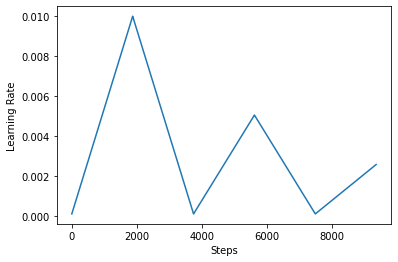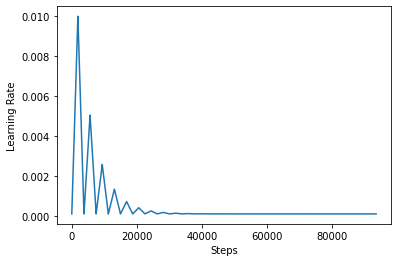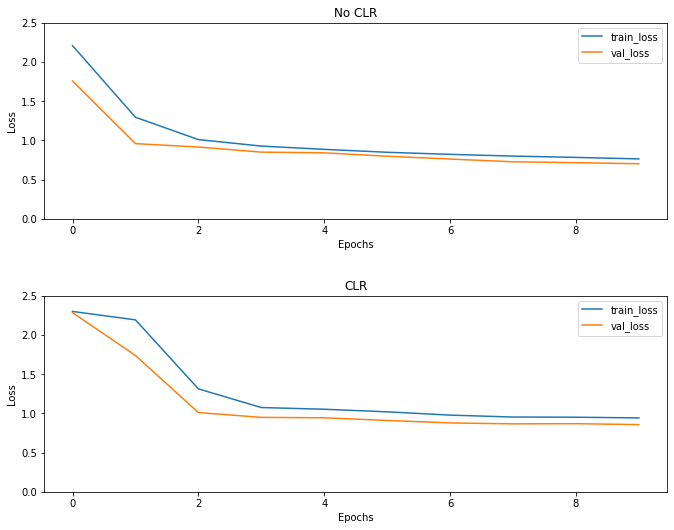 View on TensorFlow.org View on TensorFlow.org
|
 Run in Google Colab Run in Google Colab
|
 View source on GitHub View source on GitHub
|
 Download notebook Download notebook
|
Overview
This tutorial demonstrates the use of Cyclical Learning Rate from the Addons package.
Cyclical Learning Rates
It has been shown it is beneficial to adjust the learning rate as training progresses for a neural network. It has manifold benefits ranging from saddle point recovery to preventing numerical instabilities that may arise during backpropagation. But how does one know how much to adjust with respect to a particular training timestamp? In 2015, Leslie Smith noticed that you would want to increase the learning rate to traverse faster across the loss landscape but you would also want to reduce the learning rate when approaching convergence. To realize this idea, he proposed Cyclical Learning Rates (CLR) where you would adjust the learning rate with respect to the cycles of a function. For a visual demonstration, you can check out this blog. CLR is now available as a TensorFlow API. For more details, check out the original paper here.
Setup
pip install -q -U tensorflow_addonsfrom tensorflow.keras import layers
import tensorflow_addons as tfa
import tensorflow as tf
import numpy as np
import matplotlib.pyplot as plt
tf.random.set_seed(42)
np.random.seed(42)
Load and prepare dataset
(x_train, y_train), (x_test, y_test) = tf.keras.datasets.fashion_mnist.load_data()
x_train = np.expand_dims(x_train, -1)
x_test = np.expand_dims(x_test, -1)
Define hyperparameters
BATCH_SIZE = 64
EPOCHS = 10
INIT_LR = 1e-4
MAX_LR = 1e-2
Define model building and model training utilities
def get_training_model():
model = tf.keras.Sequential(
[
layers.InputLayer((28, 28, 1)),
layers.experimental.preprocessing.Rescaling(scale=1./255),
layers.Conv2D(16, (5, 5), activation="relu"),
layers.MaxPooling2D(pool_size=(2, 2)),
layers.Conv2D(32, (5, 5), activation="relu"),
layers.MaxPooling2D(pool_size=(2, 2)),
layers.SpatialDropout2D(0.2),
layers.GlobalAvgPool2D(),
layers.Dense(128, activation="relu"),
layers.Dense(10, activation="softmax"),
]
)
return model
def train_model(model, optimizer):
model.compile(loss="sparse_categorical_crossentropy", optimizer=optimizer,
metrics=["accuracy"])
history = model.fit(x_train,
y_train,
batch_size=BATCH_SIZE,
validation_data=(x_test, y_test),
epochs=EPOCHS)
return history
In the interest of reproducibility, the initial model weights are serialized which you will be using to conduct our experiments.
initial_model = get_training_model()
initial_model.save("initial_model")
WARNING:tensorflow:Compiled the loaded model, but the compiled metrics have yet to be built. `model.compile_metrics` will be empty until you train or evaluate the model. WARNING:absl:Found untraced functions such as _jit_compiled_convolution_op, _jit_compiled_convolution_op while saving (showing 2 of 2). These functions will not be directly callable after loading. INFO:tensorflow:Assets written to: initial_model/assets INFO:tensorflow:Assets written to: initial_model/assets
Train a model without CLR
standard_model = tf.keras.models.load_model("initial_model")
no_clr_history = train_model(standard_model, optimizer="sgd")
WARNING:tensorflow:No training configuration found in save file, so the model was *not* compiled. Compile it manually. WARNING:tensorflow:No training configuration found in save file, so the model was *not* compiled. Compile it manually. Epoch 1/10 938/938 [==============================] - 4s 3ms/step - loss: 2.2088 - accuracy: 0.2182 - val_loss: 1.7579 - val_accuracy: 0.4108 Epoch 2/10 938/938 [==============================] - 3s 3ms/step - loss: 1.2954 - accuracy: 0.5133 - val_loss: 0.9588 - val_accuracy: 0.6488 Epoch 3/10 938/938 [==============================] - 3s 3ms/step - loss: 1.0101 - accuracy: 0.6188 - val_loss: 0.9154 - val_accuracy: 0.6586 Epoch 4/10 938/938 [==============================] - 3s 3ms/step - loss: 0.9275 - accuracy: 0.6568 - val_loss: 0.8503 - val_accuracy: 0.7002 Epoch 5/10 938/938 [==============================] - 3s 3ms/step - loss: 0.8859 - accuracy: 0.6720 - val_loss: 0.8415 - val_accuracy: 0.6665 Epoch 6/10 938/938 [==============================] - 3s 3ms/step - loss: 0.8484 - accuracy: 0.6849 - val_loss: 0.7979 - val_accuracy: 0.6826 Epoch 7/10 938/938 [==============================] - 3s 3ms/step - loss: 0.8221 - accuracy: 0.6940 - val_loss: 0.7621 - val_accuracy: 0.6996 Epoch 8/10 938/938 [==============================] - 3s 3ms/step - loss: 0.7998 - accuracy: 0.7010 - val_loss: 0.7274 - val_accuracy: 0.7279 Epoch 9/10 938/938 [==============================] - 3s 3ms/step - loss: 0.7834 - accuracy: 0.7063 - val_loss: 0.7159 - val_accuracy: 0.7446 Epoch 10/10 938/938 [==============================] - 3s 3ms/step - loss: 0.7640 - accuracy: 0.7134 - val_loss: 0.7025 - val_accuracy: 0.7466
Define CLR schedule
The tfa.optimizers.CyclicalLearningRate module return a direct schedule that can be passed to an optimizer. The schedule takes a step as its input and outputs a value calculated using CLR formula as laid out in the paper.
steps_per_epoch = len(x_train) // BATCH_SIZE
clr = tfa.optimizers.CyclicalLearningRate(initial_learning_rate=INIT_LR,
maximal_learning_rate=MAX_LR,
scale_fn=lambda x: 1/(2.**(x-1)),
step_size=2 * steps_per_epoch
)
optimizer = tf.keras.optimizers.SGD(clr)
Here, you specify the lower and upper bounds of the learning rate and the schedule will oscillate in between that range ([1e-4, 1e-2] in this case). scale_fn is used to define the function that would scale up and scale down the learning rate within a given cycle. step_size defines the duration of a single cycle. A step_size of 2 means you need a total of 4 iterations to complete one cycle. The recommended value for step_size is as follows:
factor * steps_per_epoch where factor lies within the [2, 8] range.
In the same CLR paper, Leslie also presented a simple and elegant method to choose the bounds for learning rate. You are encouraged to check it out as well. This blog post provides a nice introduction to the method.
Below, you visualize how the clr schedule looks like.
step = np.arange(0, EPOCHS * steps_per_epoch)
lr = clr(step)
plt.plot(step, lr)
plt.xlabel("Steps")
plt.ylabel("Learning Rate")
plt.show()

In order to better visualize the effect of CLR, you can plot the schedule with an increased number of steps.
step = np.arange(0, 100 * steps_per_epoch)
lr = clr(step)
plt.plot(step, lr)
plt.xlabel("Steps")
plt.ylabel("Learning Rate")
plt.show()

The function you are using in this tutorial is referred to as the triangular2 method in the CLR paper. There are other two functions there were explored namely triangular and exp (short for exponential).
Train a model with CLR
clr_model = tf.keras.models.load_model("initial_model")
clr_history = train_model(clr_model, optimizer=optimizer)
WARNING:tensorflow:No training configuration found in save file, so the model was *not* compiled. Compile it manually. WARNING:tensorflow:No training configuration found in save file, so the model was *not* compiled. Compile it manually. Epoch 1/10 938/938 [==============================] - 3s 3ms/step - loss: 2.3005 - accuracy: 0.1165 - val_loss: 2.2852 - val_accuracy: 0.2375 Epoch 2/10 938/938 [==============================] - 3s 3ms/step - loss: 2.1930 - accuracy: 0.2397 - val_loss: 1.7384 - val_accuracy: 0.4520 Epoch 3/10 938/938 [==============================] - 3s 3ms/step - loss: 1.3132 - accuracy: 0.5055 - val_loss: 1.0109 - val_accuracy: 0.6493 Epoch 4/10 938/938 [==============================] - 3s 3ms/step - loss: 1.0748 - accuracy: 0.5930 - val_loss: 0.9493 - val_accuracy: 0.6625 Epoch 5/10 938/938 [==============================] - 3s 3ms/step - loss: 1.0530 - accuracy: 0.6028 - val_loss: 0.9441 - val_accuracy: 0.6523 Epoch 6/10 938/938 [==============================] - 3s 3ms/step - loss: 1.0199 - accuracy: 0.6172 - val_loss: 0.9101 - val_accuracy: 0.6617 Epoch 7/10 938/938 [==============================] - 3s 3ms/step - loss: 0.9780 - accuracy: 0.6345 - val_loss: 0.8785 - val_accuracy: 0.6755 Epoch 8/10 938/938 [==============================] - 3s 3ms/step - loss: 0.9536 - accuracy: 0.6486 - val_loss: 0.8666 - val_accuracy: 0.6907 Epoch 9/10 938/938 [==============================] - 3s 3ms/step - loss: 0.9512 - accuracy: 0.6496 - val_loss: 0.8690 - val_accuracy: 0.6868 Epoch 10/10 938/938 [==============================] - 3s 3ms/step - loss: 0.9425 - accuracy: 0.6526 - val_loss: 0.8570 - val_accuracy: 0.6921
As expected the loss starts higher than the usual and then it stabilizes as the cycles progress. You can confirm this visually with the plots below.
Visualize losses
(fig, ax) = plt.subplots(2, 1, figsize=(10, 8))
ax[0].plot(no_clr_history.history["loss"], label="train_loss")
ax[0].plot(no_clr_history.history["val_loss"], label="val_loss")
ax[0].set_title("No CLR")
ax[0].set_xlabel("Epochs")
ax[0].set_ylabel("Loss")
ax[0].set_ylim([0, 2.5])
ax[0].legend()
ax[1].plot(clr_history.history["loss"], label="train_loss")
ax[1].plot(clr_history.history["val_loss"], label="val_loss")
ax[1].set_title("CLR")
ax[1].set_xlabel("Epochs")
ax[1].set_ylabel("Loss")
ax[1].set_ylim([0, 2.5])
ax[1].legend()
fig.tight_layout(pad=3.0)
fig.show()

Even though for this toy example, you did not see the effects of CLR much but be noted that it is one of the main ingredients behind Super Convergence and can have a really good impact when training in large-scale settings.
